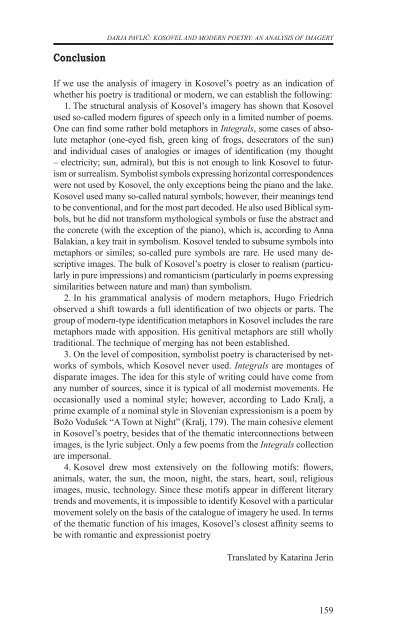razprave (pdf) - Društvo za primerjalno književnost - ZRC SAZU
razprave (pdf) - Društvo za primerjalno književnost - ZRC SAZU
razprave (pdf) - Društvo za primerjalno književnost - ZRC SAZU
- No tags were found...
Create successful ePaper yourself
Turn your PDF publications into a flip-book with our unique Google optimized e-Paper software.
ConclusionDarja pavlič: KOSOVEL AND MODERN POETRY: AN ANALYSIS OF IMAGERYIf we use the analysis of imagery in Kosovel’s poetry as an indication ofwhether his poetry is traditional or modern, we can establish the following:1. The structural analysis of Kosovel’s imagery has shown that Kosovelused so-called modern figures of speech only in a limited number of poems.One can find some rather bold metaphors in Integrals, some cases of absolutemetaphor (one-eyed fish, green king of frogs, desecrators of the sun)and individual cases of analogies or images of identification (my thought– electricity; sun, admiral), but this is not enough to link Kosovel to futurismor surrealism. Symbolist symbols expressing horizontal correspondenceswere not used by Kosovel, the only exceptions being the piano and the lake.Kosovel used many so-called natural symbols; however, their meanings tendto be conventional, and for the most part decoded. He also used Biblical symbols,but he did not transform mythological symbols or fuse the abstract andthe concrete (with the exception of the piano), which is, according to AnnaBalakian, a key trait in symbolism. Kosovel tended to subsume symbols intometaphors or similes; so-called pure symbols are rare. He used many descriptiveimages. The bulk of Kosovel’s poetry is closer to realism (particularlyin pure impressions) and romanticism (particularly in poems expressingsimilarities between nature and man) than symbolism.2. In his grammatical analysis of modern metaphors, Hugo Friedrichobserved a shift towards a full identification of two objects or parts. Thegroup of modern-type identification metaphors in Kosovel includes the raremetaphors made with apposition. His genitival metaphors are still whollytraditional. The technique of merging has not been established.3. On the level of composition, symbolist poetry is characterised by networksof symbols, which Kosovel never used. Integrals are montages ofdisparate images. The idea for this style of writing could have come fromany number of sources, since it is typical of all modernist movements. Heoccasionally used a nominal style; however, according to Lado Kralj, aprime example of a nominal style in Slovenian expressionism is a poem byBožo Vodušek “A Town at Night” (Kralj, 179). The main cohesive elementin Kosovel’s poetry, besides that of the thematic interconnections betweenimages, is the lyric subject. Only a few poems from the Integrals collectionare impersonal.4. Kosovel drew most extensively on the following motifs: flowers,animals, water, the sun, the moon, night, the stars, heart, soul, religiousimages, music, technology. Since these motifs appear in different literarytrends and movements, it is impossible to identify Kosovel with a particularmovement solely on the basis of the catalogue of imagery he used. In termsof the thematic function of his images, Kosovel’s closest affinity seems tobe with romantic and expressionist poetryTranslated by Katarina Jerin159
















